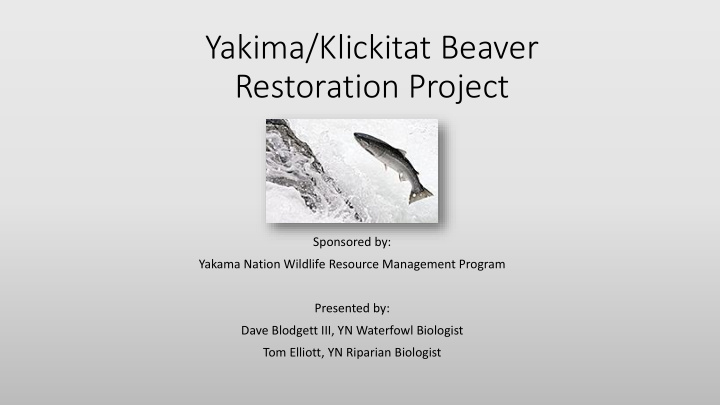



Yakima/Klickitat Beaver Restoration Project Sponsored by: Yakama Nation Wildlife Resource Management Program Presented by: Dave Blodgett III, YN Waterfowl Biologist Tom Elliott, YN Riparian Biologist
What is the Yakama Nation Wildlife Resource Management Program? Mission Statement: Protect, restore and enhance the ecosystem integrity and traditional use of wildlife and other natural resources while supporting a culturally and economically strong, self-governing Sovereign Nation.
Yakama Nation Resource Values: Water First
Riparian and Wetland Program: Protecting and restoring YN wetland resources Integrate tribal and scientific knowledge to restore floodplain habitat. Protect, restore and manage large, contiguous areas. Over 21,000 acres protected, 4000 acres of wetland managed, 590 acres of water rights returned to instream flow. Connect dewatered floodplain wetlands and channels.
Yakima/Klickitat Beaver Restoration Project Benefits • Increased water retention and base flow • Decreased peak flows • Expand habitat area and complexity • Reconnect floodplain • Increase groundwater recharge • Sediment Retention • Temperature moderation • Nutrient cycling and decontamination
Project Goals ■ ■ Increase beaver population in Restore hydrological headwater streams connection between channel and floodplain-inundation ■ Increase water quality and, frequency and duration potentially, quantity locally and ■ downstream Increase area and quality of wetland and riparian habitat- ■ Develop low-cost restoration ponding, complex habitat methods for smaller streams mosaic, meadows and meadows
What do we know ? • Beaver Biology • Traditional Ecological Knowledge and cultural values • Scientific Support
Beaver 101: The Colony • Colony unit = 6−8 related individuals • Avg. litters = 2−5 kits • Young stay with parents at least 2 years • Adults (>2 yrs) disperse to establish new lodge, 1 – 25k away from natal site • Territories marked with scent mounds • Home ranges tend to follow John Stella shorelines in lakes, ~1km in streams • Colony saturation densities vary with landscape and region
Photo by Anna M. Harrison Yes, that’s all well and good, but what we’re really here to learn about is… BEAVER DAMS • Created to impound water around lodge • Dam location / repair cued by running water • Dams constructed of wood and available debris (e.g., plastic, metal) • Dams are porous and not permanent • Where palatable species are rare, conifers are used more in dams, with hardwoods saved for the food cache
Tribal Knowledge- Values ■ Elders and other tribal members remember more dams and beavers on the landscape ■ References to specific locals: “Beavers used to run Toppenish Creek”, beavers along Dry Creek before overgrazing ■ Cultural plants in meadows being lost, perhaps because of reduced beaver dams ■ Guide us in what to do (bring back beavers) and where
Scientific Support- Modelling, Assessments, Monitoring ■ BRAT (Beaver Restoration Assessment Tool) ■ Mapping of beaver dams ■ Rapid Meadow Assessment in 2011 (RMA) ■ Meadow Vulnerability Assessment in 2018 ■ Adaptive approach-need to monitor in cost-effective manner
MacFarlane et al 2018
Klickitat River Putting it all together! ■ Using Tribal knowledge and science assess general locations- Medicine Valley, Dry Creek, Upper Klickitat, etc ■ Select sites using input from models, assessments, and staff knowledge-preference for focusing on water- sheds ■ Choose areas where restoration can be efficient and sustainable ■ Implement and monitor. Pre-monitor where possible.
Now what? Types of Beaver Restoration • Passive actions that protect beaver • Moratorium • Increased regulation/lower limits • Grazing deferment • Actively transplant beavers into areas with few or no beaver but high potential • Active habitat manipulation to mimic beaver activity • Beaver Dam Analogs • Bank attached structures • Choke Structures, etc.
Active Translocation • Capture and “Hard” Release (Most) • Often “nuisance beavers” • Good to do with 2 year old beavers • Capture, Hold, and “Soft” Release (Some) • Often mature pairs and young • Prepare site (BDAs) then begin translocation (Few) • Sites that have some limiting factors (e.g., lack of pools) but high potential • Example: Proposed South Fork Simcoe Creek Project
Step 1 Step 2 Step 3
Holding Facilities
Proposed Projects for 2018-19 • Restore 2-3 sites in 2018 • Bear Creek • South Fork Simcoe Creek • South Fork Dry Creek • Funding is through the NRCS’ Resource Conservation Partners Program (RCCP)
Bear Creek
Beaver Dam Analogues
Questions?
Recommend
More recommend